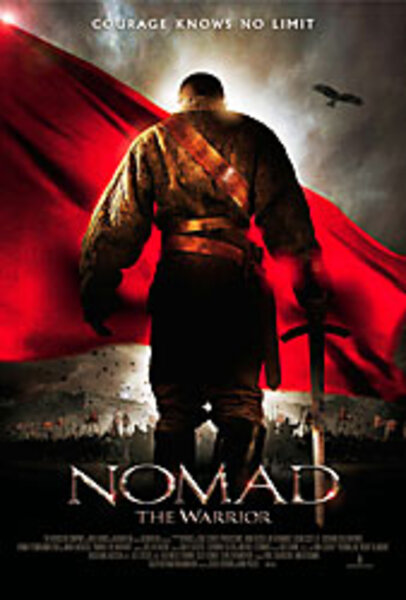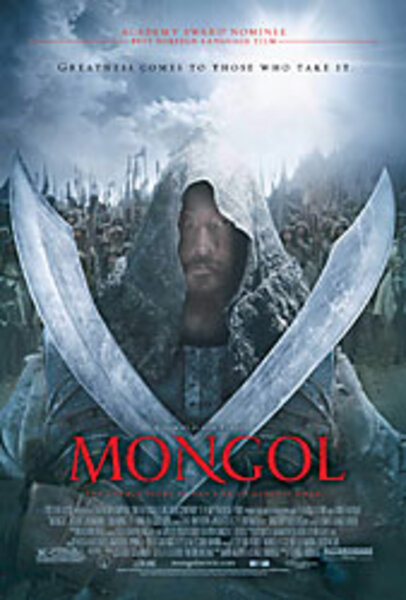Kazakhstan seeks identity on the big screen
Loading...
| Almaty, Kazakhstan
If the satirical movie "Borat" spoofed an entire nation, then "Mongol" was a decent counterpunch, casting back 800 years to the glory of a world conqueror, and earning Kazakhstan its first nomination for a foreign-language Academy Award earlier this year.
But "Mongol" was more than a big-budget Genghis Khan biopic, says Gulnara Sarsenova, the perfume and cosmetics magnate who helped bankroll the $23 million production. It also aimed to bolster the self-respect of a traditionally nomadic people aggressively Russified during 70 years of Soviet domination.
"There's a lack of awareness among Kazakhs of our rich and interesting past," says the flamboyant CEO, who is from the Naiman clan of northeastern Kazakhstan. That's the same clan of Borte, Khan's empress, whose charms in the movie brought out the sensitive side of the Mongol pillager. "I wanted to show that Kazakh history goes much further, is much deeper, than we'd ever thought."
As a coproducer of "Mongol," Ms. Sarsenova is at the forefront of efforts to reconnect Kazakhs to their ancestors, especially through film. While "Mongol" – with its Russian director, international cast, and global audience – is still a rare, privately funded exception, more typical are the dozens of historical films for domestic consumption that state-run Kazakhfilm has churned out since independence in 1991.
Kazakh-language programs face a daunting challenge, though. Stretching across a region the size of Western Europe, this sparsely populated nation is 47 percent Kazakh and 44 percent ethnic Russian. While homes in even the most remote Kazakh villages boast their own television, Russian media and Russian-dubbed Western fare dominate the tube.
Moreover, as roughly half of Kazakhfilm's movies romanticize bygone Kazakh heroes – an answer to the Soviet propaganda that began with the 1917 revolution – some wonder where the need to educate crosses into propaganda of its own.
But, asks Slambek Tauyekel, vice president and chief editor of Kazakhfilm, "what is propaganda? It tries to make everyone think the same way.
"We hope everyone will understand our films in their own way," adds Mr. Tauyekel, a 50-something filmmaker dressed sleekly in black leather sportcoat.
"This isn't about counterpropaganda, but healing and restoring Kazakh souls."
• • •
Sarsenova, herself, once dreamed of a career in movies. Though her father was a member of one of the poorer Kazakh clans he rose to become a high-ranking Communist official.
"He spoke a lot of socialism, and that if it weren't for the Soviet system, he would still have been a shepherd," she says, but adds that he quietly nurtured her national identity. "One thing he always said was, 'One must never forget his ancestors.' "
Sarsenova briefly attended the prestigious Russian State Institute of Cinematography in Moscow, but her father didn't tolerate her flight of fancy for long and ordered her back to Almaty, to "get a legitimate degree." She settled for a journalism degree from Kazakh State University.
Kazakhstan's independence opened the door to private enterprise – and the glamour Sarsenova craved. A self-described "pioneer" of Kazakh commerce, she built an empire of two-dozen luxury boutiques across the country, known as "French House." Her flagship Almaty store is fronted by a glitzy replica of the Eiffel Tower, emblazoned with interlocking neon hearts.
When Sarsenova was approached in 2004 to sponsor "Mongol," she says, the script plucked at her patriotic heartstrings: "It was a question of fate." She became one of five producers.
• • •
Early on, the Soviets appreciated film as a tool for shaping identity. With so many ethnic groups in its yoke, Moscow steered clear of anything that might kindle national sentiment. In Central Asia, Soviet-controlled film studios in Kazakhstan, Uzbekistan, Kyrgyzstan, Turkmenistan, and Tajikistan produced work that praised Stalin, promoted the notion of "Soviet man," or prodded Islamic women to lift their veils. The Kazakhs themselves were portrayed as rescued from a primitive existence. Meanwhile, they also endured a unique trifecta of trauma at Moscow's hands: the famine of Stalin's forced collectivization that killed a million Kazakhs, a network of concentration camps that constituted the southern flank of Stalin's notorious gulag, and four decades of above-ground nuclear testing that turned Kazakh farmers into human guinea pigs.
As the Soviet empire began to crumble, Kazakhfilm was among the first to find its voice, delving into Kazakh history. This was further fueled by the fact that Kazakhs didn't have to fight for independence, as other ex-Soviet republics did, says Kazakh film critic Gulnara Abikeyeva.
"We had to look for the roots of honor and bravery, through films about our national heroes," says Ms. Abikeyeva. "We received independence, but not in our minds or in our culture."
The pinnacle was the 2005 film "Nomad," a pet project of the authoritarian president, Nursultan Nazarbayev. The government shelled out $37 million for the film, an unheard of sum in these parts. Marked by lush cinematography, it opened and closed with commentary from Mr. Nazarbayev himself.
Kazakhfilm, though, is otherwise strapped for cash, deprived of the heavy Soviet-era state subsidies. On its once-proud campus, set against the backdrop of the snowcapped Tien Shan mountain range, the studios are rich with props that constitute one of the largest collections of folkloric crafts in the country – from stacks of colorful handmade carpets to carved furniture and leather containers for kumiss, the national drink of fermented horse milk.
But signs of neglect are everywhere: marble stairs are chipped, linoleum hallways buckle, light bulbs are burned out or missing. Staff levels are one-quarter those of Soviet times; production costs rarely top $1 million. (A visiting journalist is asked several times, hopefully, if he's a potential investor.)
Still, Kazakhfilm crackles with creativity. In the animation department, a storyboard pasted to the wall tells the tale of an old woman whose lone goat is gobbled by a wolf. Only the tailbone is left behind. On the carpeted floor of their traditional nomadic yurt, that bone turns into a baby boy – delivering a miracle to an elderly couple that had long yearned for a child. It also reminds them of the harmony of nature.
The animator of this childrens' film, Kayergali Kassymol, says there was a time when Kazakh elders on the steppes transmitted such values to their children and grandchildren. "Now it's the television that educates their children, which is why we're bringing our oral tradition to TV," he says. "We must educate this generation that they have their own culture, their own nomadic roots. While religions, states, and countries come and go, culture is what remains."
But, notes the critic Abikeyeva, "if you were to look just at the majority of our films, you'd get the sense we're living in the 19th or early 20th century."
The Ministry of Culture seems to agree and recently told Kazakhfilm to plow new terrain, says Tauyekel, the chief editor. He doesn't share that view, but adds, "Because we depend on their financial support, we have to be very polite."
With the success of "Mongol," there's hope that new oil wealth – Kazakhstan sits atop one of the world's largest reserves – will trigger a flow of petrodollars into the film industry. Not only historical films, but the stuff of 21st-century society – detective thrillers, romantic comedies.
"If Hollywood is an army, then here we have half a battalion," says Vladimir Tatenko, a TV producer and veteran documentarymaker for Kazakhfilm. "So I'd like to ask those now buying yachts or football clubs – why not invest in cinema?"
• • •
Sarsenova is doing her part, she says. The next coproduction of her Eurasia Film Production company is "Tulip," a contemporary film about a Kazakh shepherd who falls in love on the steppes.
Meanwhile, her father's own national spirit has awakened, and he's proud her work "contributes to raising the level of Kazakh self-awareness," says Sarsenova. "Back then, he cared about the future of the Soviet Union – now he cares about the future of Kazakhstan."







